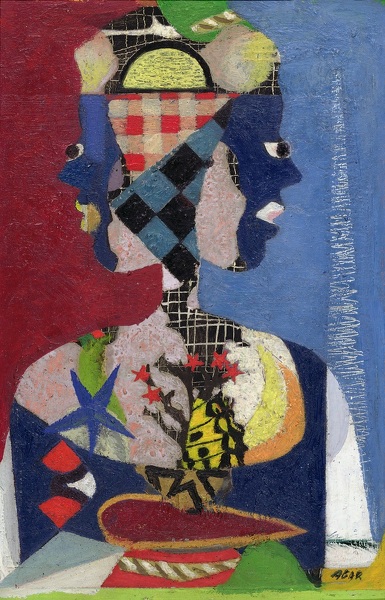

Eileen Agar (1899-1991):
The Happy Breakfast, 1937
Framed (ref: 9971)
Oil on canvas
Signed
30 x 19.5 cm
See all works by Eileen Agar oil women Fifty Works by Fifty British Women Artists 1900 - 1950
Provenance: The Sherwin Family
One of the key signatures of Surrealism was the inspired juxtaposition of collage, and Agar practised this resource with sustained inventiveness. Although this exquisite small painting does not employ collage as such, it mimics the formal procedures of collage (the variation of texture, the juxtaposition of unrelated imagery), with Agar using the wooden end of the paintbrush to scratch through the paint layers, thus varying the surface and breaking up the colour. The distinctive patterning, which alternates geometric chequering with organic star(fish) and flowering foliage, is typical of the way she built up a complex image from discrete parts which were eventually resolved into a new and unexpectedly harmonious unity. The mazy black linearity in the centre of the figure’s chest recalls the patterns of the black Victorian cut papers she collected and also the decoration on African bark cloth she used in other works of the period. The Janus double-profile – the Roman god of entrances and exits, looking both ways – features frequently in Agar’s work of the 1930s. In fact, she loved the human profile and made innumerable variations on it through a long career. Happy Breakfast is clearly intended as a cheerful image and might also allude to the lovers coming and going in her life at this time: Agar had an affair with the French poet Paul Éluard and a more long-lasting liaison with Paul Nash, and was touched in her art by both.
Commentary by Andrew Lambirth, writer, critic and curator who assisted Eileen Agar to write her autobiography (published as A Look at My Life in 1988) and curated the Agar retrospective exhibition An Eye for Collage at Pallant House Gallery in 2008.
 British Neo-Romanticism
British Neo-Romanticism



